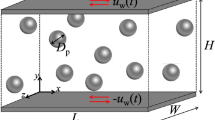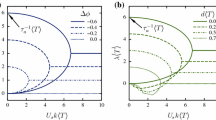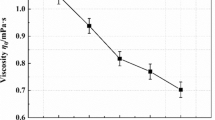Abstract
Suspensions of swimming microorganisms are a class of active suspensions that show an interesting rheological response in steady shear flow. In particular, the particle contribution to the viscosity can be negative, which has been calculated from models and measured experimentally. In this article, the material functions in large-amplitude oscillatory shear (LAOS) flow are calculated. In addition to the linear material functions, the nonlinearities are quantified analytically using the intrinsic nonlinear material functions. The particle contribution to both the storage and loss modulus can be negative. Since the suspending fluid is assumed Newtonian (and so has no storage modulus), the overall storage modulus can be negative. The intrinsic nonlinearities also show differences between passive and active suspensions. At small frequency, the active swimming can change the sign of the material functions. However, the viscous material functions are independent of the swimming motion at a very large frequency. The changes in sign of the material functions and the unique dependence on frequency may act as a rheological fingerprint of suspensions of swimming organisms.






Similar content being viewed by others
References
Batchelor G (1970) The stress system in a suspension of force-free particles. J Fluid Mech 41(3):545–570
Bird R, Armstrong R, Hassager O (1987) Dynamics of polymeric liquids Kinetics, vol 2. Wiley, NY
Bird R, Giacomin A, Schmalzer A, Aumnate C (2014) Dilute rigid dumbbell suspensions in large-amplitude oscillatory shear flow: shear stress response. J Chem Phys 140(7):074904
Bozorgi Y, Underhill PT (2013) Role of linear viscoelasticity and rotational diffusivity on the collective behavior of active particles. J Rheol 57 (2):511–533
Chen D T, Lau A, Hough L A, Islam M F, Goulian M, Lubensky TC, Yodh AG (2007) Fluctuations and rheology in active bacterial suspensions. Phys Rev Lett 99(14):148302
Chen P, Zhang Q (2011) Dynamical solutions for migration of chiral DNA-type objects in shear flows. Phys Rev E 84:056309
Chilukuri S, Collins CH, Underhill PT (2014) Impact of external flow on the dynamics of swimming microorganisms near surfaces. J Phys: Condens Matter 26:115101
Ewoldt RH (2013) Defining nonlinear rheological material functions for oscillatory shear. J Rheol 57(1):177–195
Ewoldt RH, Bharadwaj NA (2013) Low-dimensional intrinsic material functions for nonlinear viscoelasticity. Rheol Acta 52:201–219
Gachelin J, Miño G, Berthet H, Lindner A, Rousselet A, Clément É (2013) Non-newtonian viscosity of Escherichia coli suspensions. Phys Rev Lett 110(26):268103
Giacomin A, Bird R, Johnson L, Mix A (2011) Large-amplitude oscillatory shear flow from the corotational Maxwell model. J Non-Newtonian Fluid Mech 166(19):1081–1099
Giomi L, Liverpool TB (2010) Sheared active fluids: thickening, thinning, and vanishing viscosity. Phys Rev E 81(5):051908
Gyrya V, Lipnikov K, Aranson I, Berlyand L (2011) Effective shear viscosity and dynamics of suspensions of micro-swimmers from small to moderate concentrations. J Math Biol 62(5):707–740
Haines BM, Aranson IS, Berlyand L, Karpeev DA (2008) Effective viscosity of dilute bacterial suspensions: a two-dimensional model. Phys Biol 5(4):046003
Hatwalne Y, Ramaswamy S, Rao M, Simha RA (2004) Rheology of active-particle suspensions. Phys Rev Lett 92(11):118101
Hinch E, Leal L (1972) The effect of Brownian motion on the rheological properties of a suspension of non-spherical particles. J Fluid Mech 52(04):683–712
Hinch E, Leal L (1976) Constitutive equations in suspension mechanics. Part 2: approximate forms for a suspension of rigid particles affected by Brownian rotations. J Fluid Mech 76(01):187–208
Hyun K, Wilhelm M, Klein CO, Cho KS, Nam JG, Ahn KH, Lee SJ, Ewoldt RH, McKinley GH (2011) A review of nonlinear oscillatory shear tests: analysis and application of large amplitude oscillatory shear (LAOS). Prog Polym Sci 36(12):1697–1753
Jeffery GB (1922) The motion of ellipsoidal particles immersed in a viscous fluid. Proc Royal Soc A 102(715):161–179
Leal L, Hinch E (1971) The effect of weak Brownian rotations on particles in shear flow. J Fluid Mech 46(04):685–703
Rafaï S, Jibuti L, Peyla P (2010) Effective viscosity of microswimmer suspensions. Phys Rev Lett 104(9):098102
Rogers SA (2012) A sequence of physical processes determined and quantified in LAOS: an instantaneous local 2D/3D approach. J Rheol 56(5):1129–1151
Rusconi R, Guasto JS, Stocker R (2014) Bacterial transport suppressed by fluid shear. Nature Phys 10:212–217
Saintillan D (2010a) The dilute rheology of swimming suspensions: a simple kinetic model. Exp Mech 50(9):1275–1281
Saintillan D (2010b) Extensional rheology of active suspensions. Phys Rev E 81(5):056307
Sokolov A, Aranson IS (2009) Reduction of viscosity in suspension of swimming bacteria. Phys Rev Lett 103:148101
Wilhelm M (2002) Fourier-transform rheology. Macromol Mater Eng 287(2):83–105
Acknowledgements
The authors gratefully acknowledge support from the National Science Foundation grant no. CBET-0954445.
Author information
Authors and Affiliations
Corresponding author
Appendices
Appendix 1: Formula for the stress
There are two common representations of long slender objects used in the literature. The first is a series of spherical beads connected by rigid rods, in which only the positions of the beads are tracked (rotations of the spheres do not matter). This model has been extensively described in Bird et al. (1987). In the notation used in this article, the flow and Brownian contributions of the particles to the stress are
where \(\lambda _{N}^{(1)}\) is the time constant of the object composed of N beads that is related to the rotational diffusivity D r while \(\lambda _{N}^{(2)}\) is a time constant related to the drag on the object. Note that the Brownian contribution is the same as that used in this article, while the flow contribution differs in the use of κ. However, κ = Γ − Ω. When inserting this into the flow contribution, the vorticity contribution equals zero since Ω is antisymmetric. Therefore, our formulas match this model with \(H=\lambda _{N}^{(2)}/\lambda _{N}^{(1)}\). Values of this ratio are given in Bird et al. (1987). If hydrodynamic interactions between beads are ignored, then H = 1. If hydrodynamic interactions are included, H depends on the number and radius of the beads and can be either larger or smaller than one. How H deviates from one determines the sign of the second normal stress coefficient in steady shear flow for passive particles.
The other commonly used model of long slender objects is a spheroid with large aspect ratio. The stress in a dilute suspension of spheroids has been previously examined extensively. In the notation of this article, the Brownian contribution is (Hinch and Leal 1976)
where μ is the viscosity of the Newtonian suspending fluid, V part is the volume of a single particle, and F is a function of the particle shape given by Hinch and Leal (1972) as
where r is the aspect ratio and K 3 and K 1 are integrals given by Leal and Hinch (1971) as
The rotational diffusivity is also related to these functions as (Leal and Hinch 1971)
Placing these expressions into the Brownian stress formula leads to
which matches with the expression used in this article when \(r \to \infty \).
In the notation of this article, the flow contribution is (Hinch and Leal 1976)
where A, B, and C are functions of the particle shape as given in Hinch and Leal (1972) as
where the I’s and J’s are integrals defined by Batchelor (1970). The limiting behaviors of these factors are given in Hinch and Leal (1972). For \(r \to \infty \), they are
In this limit, B approaches zero, C approaches a constant, while A approaches infinity. Therefore, for slender objects, we can express the flow contribution as
This expression and the one used in the article would be the same if
In the limit \(r \to \infty \),
Using this limit and the limit of A shows that H = 1/2 for spheroids with \(r \to \infty \).
Appendix 2: Distribution function and material functions
Equations (12)–(14) express the distribution function in terms of the dependence on strain and time. In particular, the function Ψ1 is expressed in terms of A 11 and B 11. The functions A 11 and B 11 satisfy the coupled differential equations
To solve these equations, we follow the approach used in Bird et al. (1987) in which we expand A 11 and B 11 in terms of the real-valued spherical harmonics \({P_{k}^{j}} \sin (j \phi )\) and \({P_{k}^{j}} \cos (j \phi )\), where \({P_{k}^{j}}\) are the Legendre polynomials with \(\cos \theta \) as their argument. The spherical harmonics are eigenfunctions of the Laplacian operator. Note that they are not eigenfunctions of the Ω s operator, which leads to coupling between the spherical harmonics. The details of how Ω s operates on the spherical harmonics is given in Bird et al. (1987). Since \({\Omega }_{s} {\Psi }_{0} = -{P^{2}_{2}} \sin (2 \phi ) /(8 \pi )\), then A 11 and B 11 will only have a single spherical harmonic and are given by
These functions can then be used to compute the linear viscoelastic functions using Eqs. (18) and (19). This is done most simply using the fact that \(n_{x} n_{y} = {P_{2}^{2}} \sin (2 \phi )/6\) and using the orthogonality of the spherical harmonics. By performing the integrals, we can show that
The solution for Ψ1 can now be placed into the equation for Ψ2, which becomes
Using the expansion of Ψ2 in time leads to three coupled PDEs for the angular functions that are given by
These equations are solved by expanding in spherical harmonics. They are being forced by the nonhomogeneous terms with Ω s . Therefore, we use the relationship that
where the primes on the sums denote that the integers are incremented by two and the coefficients \(a_{2k}^{2j}\) are given in Bird et al. (1987). Incorporating these coefficients gives
which can then be used to obtain
The solution for Ψ2 can be placed in the equation for Ψ3 which after using the time expansion of Ψ3 leads to the four coupled differential equations:
The nonhomogeneous terms involving Ω s are written in terms of spherical harmonics using the a factors from Bird et al. (1987), and these equations are then solved to obtain A 31, B 31, A 33, and B 33. These functions directly determine Ψ3. They are also used in Eqs. (20)–(23) to calculate the intrinsic nonlinearities. These averages are simplified by the fact that
Rights and permissions
About this article
Cite this article
Bozorgi, Y., Underhill, P.T. Large-amplitude oscillatory shear rheology of dilute active suspensions. Rheol Acta 53, 899–909 (2014). https://doi.org/10.1007/s00397-014-0806-y
Received:
Revised:
Accepted:
Published:
Issue Date:
DOI: https://doi.org/10.1007/s00397-014-0806-y




